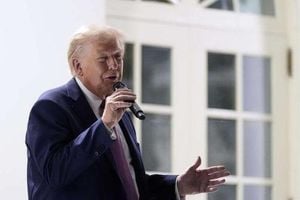The global economic stage is witnessing significant shifts as central banks, particularly the Federal Reserve, navigate through tricky waters marked by inflation and employment challenges. Since September 2024, major rate cuts have begun, fundamentally changing the monetary policy narrative and impacting various asset classes. This new rate-cutting environment is not just about numbers; it's about how these changes shape economic landscapes both domestically and globally.
Initially, the Federal Reserve announced its first interest rate cut since the onset of the COVID-19 pandemic, reducing the federal funds rate by 0.5 percentage points to 4.75-5.00% on September 18, 2024. A follow-up cut of 0.25% came in November 2024, signaling the start of what many analysts believe will be more aggressive rate reductions moving forward.
A comprehensive report from Binance Research sheds light on these developments, examining the broader economic indicators, including inflation dynamics and employment figures, and how they interplay with the market response. They noted the dual mandate of the Federal Reserve, focused on maximizing employment and stabilizing prices, which guided their initial aggressive rate hikes beginning mid-2022 when inflation spiked to over 9%. Now, as inflation trends downward, the Fed is shifting gears.
What's especially interesting about this transition is the broader economic impact it has on consumer behavior and investment strategies. With lower interest rates, borrowing becomes cheaper, effectively encouraging spending and investment. Individuals and businesses alike find it easier to finance operations, purchase homes, and invest in capital projects, effectively stimulating economic activity.
But there’s more: the ripple effects of these rate cuts extend to numerous asset classes, which have historically reacted differently to such changes. For example, the stock market, particularly the S&P 500, has traditionally witnessed upward trends following rate cuts. Historical data shows positive returns three, six, and twelve months after initial cuts, illustrating investor confidence and market resilience.
On the flip side, commodities exhibit complex relationships with interest rates, influenced by factors like inventory costs and exchange rate variations. This complexity can lead to mixed outcomes, particularly during times of rising tariffs or geopolitical tensions. Meanwhile, bond prices typically rise when interest rates fall, showcasing the inverse relationship between these two financial instruments.
Interestingly, one asset class receiving increased attention during these rate-cut periods is cryptocurrency. Although data is limited, historical performance during previous cuts, like the substantial increase of 537% over twelve months following the March 2020 cut, indicates strong speculative interest. This factor leads to intriguing queries about the future role of cryptocurrencies as alternative investments during periods of low interest and potential inflation.
Yet, as we witness this global interest rate cut narrative take shape, caution is warranted. The past does show exceptions, particularly during recessionary periods when even rate cuts may not suffice to prop up asset prices. Understanding these nuances is pivotal for investors contemplating their strategies as we roll forward through 2025 and beyond.
But wait, there’s also talk of imminent policy changes across the globe, as many central banks have initiated their rate-cutting processes, indicating synchronized movements likely to impact international financial markets, investments, and currency values. This unified approach to monetary policy could stabilize economies but may also introduce volatility as investors react to these global shifts.
Central to this economic evolution is inflation control. The Fed has set inflation targets at 2%, and keeping up with these measures remains their primary focus. There’s no easy answer to controlling inflation, especially against the backdrop of current geopolitical realities and trade policies. The interplay between tariffs on goods and their subsequent effect on overall price levels could coax inflation higher, complicate the recovery, and influence monetary policy moving forward.
The recent data releases just before the holiday season paint a mixed picture; personal spending increased by 0.4%, and personal income grew by 0.6% as reported by the Commerce Department. This increase shows resilience among U.S. households, but also highlights the persistent inflation pressures, especially within the service sector. Investors and policymakers alike are acutely aware of the dynamic economic forces at work here.
Looking to the future, the financial world anticipates potential rate cuts far exceeding the current estimates. Speculations indicate expectations of reductions between 1-2 percentage points over the next year, as economic conditions evolve. The upcoming Federal Reserve meeting on December 18 is positioned to refine economic predictions and could provide insights invaluable to investors and industry leaders.
So, with all the moving parts, what advice do experts offer? Cautious optimism. Investors should remain agile, monitoring all economic signals, including inflation trends, market sentiments, and central bank communications. Understanding the intricacies of monetary policies and their effects on various asset classes will be key as we enter this new chapter of economic recalibration.
Lastly, as we emerge from these turbulent months, it’s worth remembering this: The global economy is more interconnected than ever, which means the effects of local policies can rapidly ripple across continents, impacting everything from inflation to employment and investment strategies worldwide. Keeping abreast of these themes, changes, and adaptations will be imperative for anyone involved, whether you’re investing, policy-making, or simply observing the world economic stage.



